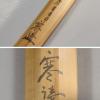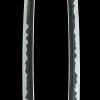Hello guys, I am the new guy here, this is my first post. So please bear with me :) Question 1: Most sword made by Bicchunokami Tachibana Yasuhiro comes with a chrysanthemum crest but also some don't. Why is that? Question 2: What is the difference between a Bizen sword sign "Bishu Osafune Norimitsu" vs just "Norimitsu" ? Is the latter a kazuuchi sword or its out right fake? |
|||
 |
Nihonto ClubJapanese Sword Information Exchange |
User login |
|
|
Disclaimer: Nihontō Club owners and independent contributors will not be held responsible for any loss, damage or inconvenience caused as a result of any inaccuracy or error within this website. Except where otherwise noted, this page is licensed under a Creative Commons License.
|



Yasuhiro
Hi Kevin,
Ok, let's start with Yasuhiro. It's an interesting question in regards to the kiku mon. I went through the books and I wasn't able to find a definitive answer as to why and even which generation of Yasuhiro was known to sign without a mon.
Few observations:
1) some 'Bitchū no Kami Tachibana Yasuhiro' swords without mon received an NBTHK cert, so the absence of the mon doesn't necessarily mean it's a fake
2) it may be either the first generation Yasuhiro before he went to Osaka, or the second generation (usually he signed with a kiku on a branch)
3) as there are many examples to compare with, it would be interesting to study the style of the signatures without kiku and compare them with known works of first/second/third generation Yasuhiro.
Here's an interesting quote from Token Bijutsu (translated by Markus Sesko in his Shinto Kantei volume):
Bitchū no Kami Yasuhiro was the most productive smith of the Kishū-Ishidō group. He moved later in his career to Ōsaka where he founded the Ōsaka-Ishidō branch and that is why he is listed in the section „Settsu“. Incidentally, there was around Keichō (慶長, 1596-1615) an earlier Kishū-Ishidō Yasuhiro active in Kii who came originally from Ōmi province. Well, Bitchū no Kami Yasuhiro applied an iriyamagata-jiri and carved a chrysanthemum on the ura side of his tangs.
Norimitsu to follow...
Regards,
Stan
Norimitsu
As for Norimitsu, there were so many of them, starting from early 1300s and spanning for almost 300 years. As you can imagine, they can be quite different. You can't say one signature is genuine and the other is fake. With 'Bishū Osafune...' (and, typically, a long signature) being the more common example, there are recorded examples of 'better' Norimitsu who signed in nijimei. The second picture, for instance, is a Juyo sword. I'm not familiar with the first one but it looks impressive on the picture. I would say it's a typical situation when one needs to judge the sword, not the signature (as true for many prolific Bizen smiths). Depending on the sword's period, there are higher chances for it to be a kazuuchi, regardless of the actual signature.
Regards,
Stan
Thanks buddy. Greatly
Thanks buddy. Greatly appreciated